Nut, the Burmese muscle hunk bar boy from Tawan spoke close to no English when I first met him. Still a recent transplant from his home country, he had a well-developed body back then but not so massive that anyone would consider him a muscle god. With diligent work, within three years both his English and his muscles improved greatly. So do his financial situation. What never changed was his sweet disposition, his ready sense of humor, and his enjoyment of life no matter what it threw his way.
Over the course of his employment at Tawan, I offed him more than any other guy who has worked there. But our friendship developed beyond that paradigm; we often got together during his free time just to hang out. When sex wasn’t on the menu there was no money involved. And toward the end of our friendship (he has since returned to Burma to live) when we’d go out to dinner or a movie he would pay for our evening’s entertainment just as often as I would. Which has little to do with this post. It just seemed like a good time to reiterate that you can form real friendships with bar boys, that it is not always just about the money. What Nut does have to do with this post is that we spent hours talking the first time I offed him. Which was quite a feat considering he knew less than 100 English words at that time.
Nut, however, was a natural pantomime. If you could make a career out of playing Charades, he’d have been a millionaire. Included among the stories he wove that night was his tale of trying to make a living selling those little fresh flower garlands that you see all over Thailand. He awoke early each morning, bought flowers from the local market, and then built the garlands to sell on the streets of Bangkok. Perhaps it was from my living in Hawaii and my familiarity with making leis, but as soon as he began pantomiming stringing the flower buds I immediately knew what he was talking about – otherwise I’d have guessed he was trying to tell me about darning socks. His profit on each garland was 6 baht. And his work day ended by 10a.m. – for a few hours before that he’d brave Bangkok’s traffic on foot, weaving his way down the congested rows of cars while competing for a sale with those selling bagged breakfasts and lunches. Street vendors, who actually sell off the street, are a common sight in the city if you get up early enough. It’s the Thai version of a drive-through, except you do not have to deviate from the roadway. Not that Bangkok’s traffic would allow for that anyway.

Phuang malai protect Thailand’s taxi drivers from harm. That they smell better than the hot, sweaty farang who hop into their cabs all day ain’t bad either.
Nut’s part of this post ends with the note that he continued his floral offering vending career for several years while working the bar at night. Which also has nothing to do with this post. But I frequently read on the message boards that bar boys work at the clubs because it’s easy money and they are too lazy to get a real job. That’s an easy claim to make when you don’t have a clue about what you are talking about; it’s an inaccurate but convenient conclusion to arrive at when your life experiences don’t allow for the degree of poverty many of these guys are trying to climb out of. And even though I haven’t seen Nut for several years now, whenever I see a garland of jasmine flowers hanging off a taxi driver’s rearview mirror I think of him, of the hours he spent each day eking out a living, and of the 6 baht profit he considered himself blessed to be making.
Which means he crosses my mind quit often when I’m in Bangkok ‘cuz you see those little floral offerings everywhere. They are cheap, smell wonderful, and just scream Thailand. Some tourist buy them as a souvenir or to hang back in their hotel room as an air freshener. I’d heard that was a major no-no. Someone had told me they were supposed to be used as an offering at wats, a form of merit making for honoring Buddha. And you do see them at temples. But not nearly as often as you do in taxis. Or hanging in shops and stalls. So I thought I’d do a bit of research, a stab at being a myth buster on my own, and find out the true story – and purpose – of what is a common sight in Bangkok. Not surprising, that was easier said than done.
I often turn to my friend Noom when I have questions about Thai culture. And he always has an answer. Even if it means making it up on the spot. Being vague works too. So, “It smell good” while technically correct wasn’t quit the degree of detail I was looking for. But then again he was right, they do smell good, and their fragrance is partially why they are so popular in Thailand. Not that that is the end of the story. In a country where the color of the t-shirt you are wearing on any given day is rife with symbolism, you’d have to expect the intricately designed flower garlands too have a meaning of their own. It just depends on who is giving them, receiving them, or purchasing them.

Phuang malai are good luck charms on boats too, though the gods of the sea seem to prefer plastic flowers in garish colors.
Known as phuang malai the ubiquitous flower garlands of Thailand are primarily made of fragrant jasmine blossoms, but are often decorated with other colorful flowers too. They are used to pay homage to Buddha as well as any other god that strikes your fancy, serve as a form of merit making, are a symbol of welcome, either bring good luck or ward off bad luck, and yes, are often hung in front of windows as a natural air-freshener. Those you see hanging off the rearview mirror of a taxi or tuk tuk are believed to protect the vehicle and its passengers from harm, or as one pundit put it “they are a sort of the Thai equivalent of carrying a Saint Christopher medallion.”
Like the lei in Hawaii, phuang malai are often given to guests as a welcoming gift. And as with the word Aloha in Hawaii which can mean both hello and good-bye, phuang malai are also given to say farewell to friends and relatives, with the cross-over intention of wishing the recipient a safe journey (though unlike with their use by taxi drivers, you are supposed to use the phuang malai as a form of merit making at your local temple to ensure your travellers are free of danger and harm). And while it is perfectly acceptable to purchase a phuang malai to use as an air freshener, if your intention is to use it as an offering at a wat you are not supposed to stop and smell the flowers – an offering of a floral tribute to Buddha must be a total gift, sneaking a sniff or two for yourself first is considered a selfish act and lessens the meaning behind the tribute. But if you were Thai, you’d know that.
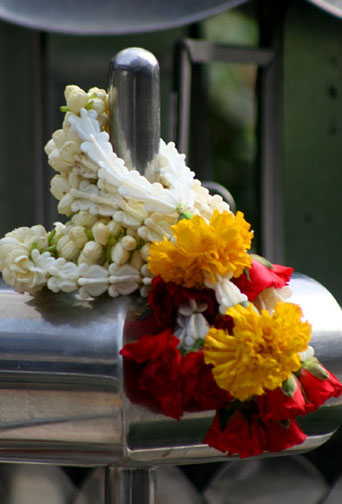
Phuang malai left as offerings at MBK – either in hopes of a good day of business by a vendor, or by a shopper hoping to be blessed with some great sale prices.
There are several different shapes of phuang malai, and the types and number of different flowers used in their construction is almost limitless. Some are circular and look like a bracelet (and yes you can wear them as such though if you are trying to convince your boy du jour you are a manly man this might not be the best idea). Others have ‘tails’ of flowers or ribbons – the elongated style you often see on the prow of long tail boats are called uba; the shorter ones with a full tassel of blossoms are malai piya. Generally, there seems to be no rhyme or reason for using one style over another, other than that the most intricate and complex designs are used to honor people of higher status. (Regardless of the shape or design, however, phuang malai given to monks or used to make merit at an image of the Buddha are supposed to only use an odd number of flowers.)
There is also no strict protocol regarding the types of flowers used, though any Thai knows the proper choice in blossom for any given reason. The most common phuang malai are made of white jasmine flowers and when used by themselves are a symbol of purity making these a popular choice for merit making at temples. Yellow Chrysanthemums, however, are a better choice for use at shrines such as the Erawan where the god in question is of Hindu extraction. And the popularity of phuang malai with a pink rose bud or two is in honor of the King, since that is supposedly his favorite flower.
Of course regardless if your intention is merit making, garnering some good luck, getting your favorite god or goddess to intervene on your behalf, or to keep bad luck from grasping you in its claws, showing how serious you are about your devotion matters. A 20 baht jasmine phuang malai is all good and well, but drop 100 baht or more on a more intricately designed garland, or one made of pricier flowers and your chances just went up. And if your phuang malai is meant to pay homage to the King, a seven-colored garland is the only way to go
There are also specific occasions when phuang malai are given as gifts, and which type or at least color of flower used in their creation then matters. For example Mother’s Day is a popular phuang malai giving occasion; you are supposed to give white garlands to your mother and other female family members older than you as a sign of respect. Or you can dis your girlfriend or wife by giving her one – on Mother’s Day, phuang malai are expected to be given to the ladies only by people much younger than they are, giving one to someone of your age bracket is the same as calling her old.
Taxis, boats, temples, and shrines are all popular places to hang phuang malai. They are also a common sight on spirit houses where their fragrance is used to please the spirits. You’ll also see them used as a symbol of honor hanging from pictures of the recently departed as well as at the grave markers in local cemeteries. I’m not sure why, other than it was both noticeable and unexpected, but I saw many phuang malai hung on the iron grated doors of stalls that had not yet opened at the Weekend Market on one early morning visit. I’m sure those were meant as a good luck charm; that boarded up shop after boarded up shop had one hanging on its door with no one pilfering them tells you the importance of their symbolism among locals. I guess ripping off someone else’s phuang malai isn’t good for your karma. No matter how good it smells.
Related Posts You Might Enjoy:

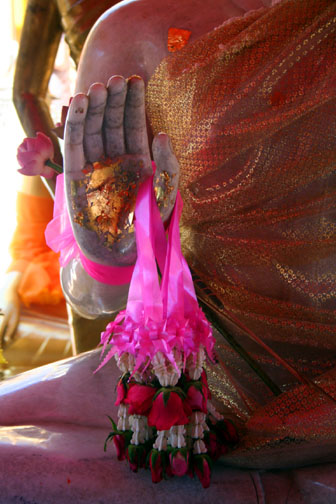
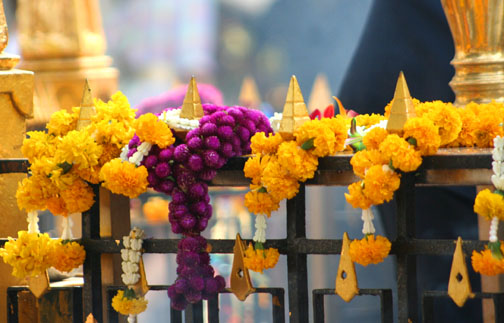

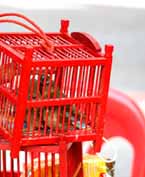

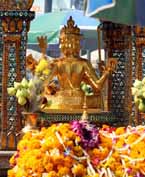
I really appreciated this one on the flower garlands. It has immeasurably added to my appreciation for Thai culture. Is there no connection with the Hawaiian custom of garlands?
Thanks Navalator. I couldn’t find any connection between the historical use of leis in Hawaii and flower garlands in Thailand. The more formalized garlands, some websites claimed, stemmed from the flower arranging skills of ladies of the Royal Court. Though I suspect their use to pay homage to the gods pre-dates that and comes from Hindu practices, which the Thais have nicely incorporated into their brand of Buddhism. If the royal court claim was actually the first use, then you could argue that King Kamehameha might have introduced the use of strung flowers when he visited Thailand in the mid 1800s. But I think it was just two cultures, among many, that first used floral tributes to honor their gods, and eventually used them as a sign of welcome, respect, and/or affection among the people.
Practical as many Thais are, I think there’s indeed no single proper way for using these garlands. The opportunities are endless… 555 Many Thais I know have a little shrine or altar at their home (I mean inside, I’m not referring to the spirit house outside), and then they use these garlands as offerings or decoration. The nice smell certainly doesn’t hurt, and for some people that might really be the main reason to buy them (instead of plastic flowers that are surprisingly popular with Thais).
Too bad that your Burmese friend has vanished without a trace, that’s always saddening! But you never know, sooner or later who might bump into him again somewhere. It never fails to amaze me how often that actually happens.
You are probably right Alex, Thais do tend to have a practical nature to their religious observations. I always notice the attendants at the Erawan shrine scooping the tributes into garbage cans to make room for more, which none of the locals seem to mind. Next visit I should watch what happens to those. I’d not be surprised to see them put back out for re-sale!